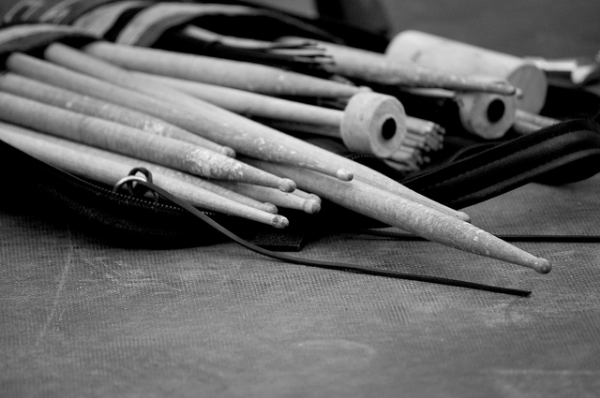As with any instrument, great starts with the source. There is nothing closer to the source than your choice of drumsticks.
Your drumsticks are literally an extension of you. Your playing, dynamics and sounds coming off of the drums and cymbals are directly related to the type of drumsticks you choose. The great (and sometimes challenging) thing about choosing the right drumsticks is there are a zillion different options to choose from.
The tricky part is falling in love with your favorite drumstick. Although once you do, you’ll know it. Even after you’ve found your favorite drumstick however, don’t just fill your stick bag with the same type. If you could take a look inside the stick bag of some of the top studio players in the world, I bet you’d find a variety of tools.
Experiment
How do you know what kind of sticks to use? The key here is to have variety and experiment. In a recording environment, try different types of woods. Try different kinds of tips. Listen back!
How does the rounded tip sound on the cymbals verses an oval tip? How does hickory respond to the heads over oak? Before you can really know what sounds and feels good to you, you have to try out different scenarios.
For example, sometimes I’ll use a ProMark Hot Rod in my left hand and a light jazz stick in my right. This adds a nice warmth to the snare hits and a crisp ping on the cymbals.
The bottom line: Try things out and be patient. Here are some basic guidelines to consider when filling up your stick bag:
Style of Music - First, consider the style of music you primarily play. If you are a session guy, you absolutely need to have a combination of brushes, jazz sticks, heavy sticks, medium sticks, etc. Be ready for the song. If you primarily play the same type of music live, you can get away with the buying a case of your favorite stick.
Wood Choice - The choice of wood material you use heavily influences the sound of your drums and cymbals. The three basic wood choices are Hickory, Maple and Oak. Experiment with all three until you find something that suits your playing style. If you’ve found some cheap drumsticks with no wood label, back away. It’s probably a combination of materials and not worth your time.
Tip Choice - The two basic tip choices to consider are wood and nylon. The more popular choice for most applications is wood. Plastic nylon tips are great for achieving a clean, articulate sound from your cymbals. In addition to the material, the size of the tip will also influence your playing and sounds.
Auxiliary Stick Choice - In my opinion, having a few auxiliary stick options is a must. Grab some broomsticks, hot rods, brushes and timpani mallets. You never know when a session or gig will call for these. More importantly, try simply playing at different volumes with each of the different styles. Try playing with two completely different sticks in your hands. Practicing in this way will dramatically increase your level of dynamic control and feel.


